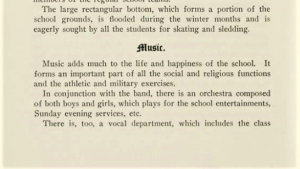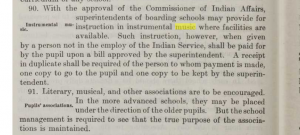Indian Schools were designed by the United States government to eliminate a threat of a generation of people whose predecessors they had slaughtered by assimilating them into the dominant Western culture. Part of this ‘Westernization’ was the role of music in the lives of the students.
 1
1
This text from 1915 is a review of an Indian School in Pennsylvania that had been put in place to train them into the “American” culture. What is of note is the focus on music as a form of entertainment as well as education. Another example is this:
As can be seen in this other guidelines of an Indian School, music is a part of the total enculturation of the students. Music had become a cultural weapon with which the United States established it’s authority. Although it never explicitly states the institution’s intention to erase and replace an entire culture, this can still be seen in the rhetoric used. One can read at the bottom of the image that these student associations that management is required to “see that the true purpose of the associations is maintained.” For those managing the school, the true purpose was the study and practice of Western music.
Music in the Indian schools had to fall within the ‘Course of Study’ prepared by the Commissioner of Indian Affairs, who, in 1915 wrote “Music opens the way to a new world of joy.” but a sentence later explains this music must be “only good music” and then lists a series of operas and patriotic music to use.2
All of these examples set up the framework and intention behind the use of music in these institutions. Music was used as a two-pronged weapon to encourage assimilation. On the one hand, it did attempt to increase an appreciation of Western music because then the students would be less inclined to look elsewhere for that fulfillment. At the same time, it worked to ignore and eliminate the multitude of Native American cultures that had existed before it. This was necessary so these students would not have these other cultural practices that could define them and create a distinct identity separate from an “American” that could present a threat against the government.
Music and these schools were a part of the larger cultural narrative that encouraged the supremacy of Western culture over anything that had been produced by the indigenous people before it and created these schools to asset that. These Indian Schools were a powerful tool that used music as a way to eliminate a threat the US Government saw to its power.
1.Carlisle Indian Industrial School. 1915. Catalogue and synopsis of courses, United States Indian School, Carlisle, Pennsylvania. Carlisle: Carlisle Indian Press. Available through: Adam Matthew, Marlborough, American Indian Histories and Cultures, http://www.aihc.amdigital.co.uk/Documents/Details/Ayer_389_C2_C2_1915 [Accessed February 20, 2018].
2. Bureau of Indian Affairs. 1915. Tentative course of study for United States Indian schools. Prepared under the direction of commissioner of Indian affairs. Available through: Adam Matthew, Marlborough, American Indian Histories and Cultures, http://www.aihc.amdigital.co.uk/Documents/Details/Ayer_386_U5_1915 [Accessed February 20, 2018].
3. United States Indian Service. 1913. Rules for the Indian School Service, 1913 / Department of the Interior, United States Indian Service. Available through: Adam Matthew, Marlborough, American Indian Histories and Cultures, http://www.aihc.amdigital.co.uk/Documents/Details/Ayer_386_U5_1913 [Accessed February 20, 2018].

